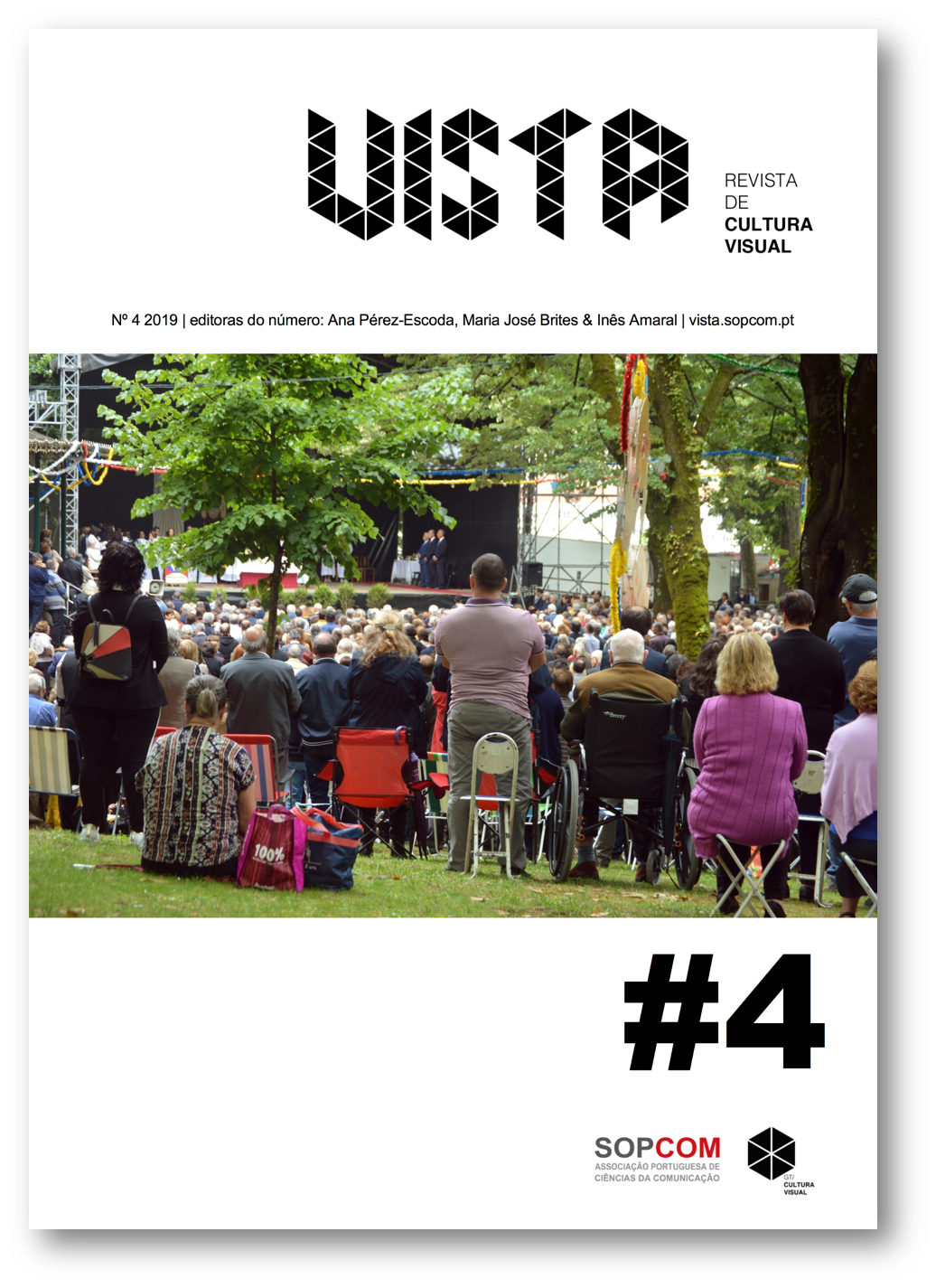Portrayal of Life Stages on Swedish Municipal Media: A Life Course Perspective
DOI:
https://doi.org/10.21814/vista.3017Keywords:
life course, life stage, media portrayal, older people, visual analysisAbstract
Media portrayal of older adults is an expression of social realities and expectations, and the image of ageing has significant implications for intergenerational relations. A life course perspective is suggested for viewing old age as the final stage of successive lifespan development and investigating the social meaning of old age through comparisons of life stages. This article focuses on the visual portrayal of citizens at a particular life stage (infancy, childhood, adolescence, adulthood and old age) in Swedish municipal new media. It aims to examine the ways that the municipality visually portrayed citizens at different life stages, as well as the media portrayal of older people that was produced from a life course perspective. This study is based on document analysis of municipal guidelines for visual language and other pertinent documents, as well as in- depth visual analysis of six representative Facebook photos published by the municipality in 2018. This article finds that the municipality has designated diversity and inclusiveness (including age) as two vital communication goals, in addition to applying a life-stage grouping technique to audience analysis. Visual analysis reveals that the visual portrayal of citizens is communicated using a set of traits attributed to the life stages represented. Specifically, these findings suggest that the particular visual components serve to categorize older people as a vulnerable group, while perpetuating age stereotypes and ageist perceptions in society.
Downloads
References
Adami, E., & Jewitt, C. (2016). Special Issue: Social media and the visual. Visual Communication, 13(3), 263–270.
Appel, M., & Weber, S. (2017). Do mass mediated stereotypes harm members of negatively stereotyped groups? A meta-analytical review on media-generated stereotype threat and stereotype lift. Communication Research DOI: 10.1177/0093650217715543.
Armstrong, T. (2007). The Human Odyssey: Navigating the Twelve Stages of Life. New York City: Sterling Publishing Company.
Bai, X. (2014). Images of ageing in society: A literature review. Journal of Population Ageing, 7(3), 231–253.
Bene, M. (2015). The political construction of old age as reflected in online discussions. Corvinus Journal of Sociology and Social Policy, 6(1), 25–45.
Bergman, Y. S., & Bodner, E. (2015). Ageist attitudes block young adults’ ability for compassion toward incapacitated older adults. International Psychogeriatrics, 27(9), 1541–1550.
Bradley, D., & Longino, C. (2001). How older people think about images of aging in advertising and the media. Generations, 25(3), 17–21.
Clair, J. M., Karp, D. A., & Yoels, W. C. (1993). Experiencing the Life Cycle: A Social Psychology of Aging. Springfield: Charles C Thomas.
Cohen, H. L. (2002). Developing media literacy skills to challenge television’s portrayal of older women. Educational Gerontology, 28(7), 599–620.
Degnen, C. (2007). Minding the gap: The construction of old age and oldness amongst peers. Journal of Aging Studies, 21(1), 69–80.
Elzinga, C. H., & Liefbroer, A. C. (2007). De-standardization of family-life trajectories of young adults: A cross-national comparison using sequence analysis. European Journal of Population/Revue européenne de Démographie, 23(3-4), 225–250.
Entwisle, D. R. (2018). Children, Schools, and Inequality. London: Routledge.
Erol, P. Ö. (2009). Social construction of Old Age among university students in Turkey. Sincronía, (1), 1–16.
Fischer, J. L., Zvonkovic, A., Juergens, C., Engler, R., & Frederick, H. (2015). Work, family, and well-being at midlife: A person-centered approach. Journal of Family Issues, 36(1), 56–86.
Foss, K. A., & Southwell, B. G. (2006). Infant feeding and the media: the relationship between Parents’ Magazine content and breastfeeding, 1972–2000.International Breastfeeding Journal, 1(1), 1–10.
Government Offices of Sweden, Ministry of Finance. (2017). The Swedish Model. Retrieved from Government Offices of Sweden website: https://www.government.se/information-material/2017/06/the-swedish-model/
Hansen, A., & Machin, D. (2013). Media and Communication Research Methods. London: Palgrave Macmillan.
Healey, T., & Ross, K. (2002). Growing old invisibly: older viewers talk television. Media, Culture & Society, 24(1), 105–120.
Henderson, L., Kitzinger, J., & Green, J. (2000). Representing infant feeding: content analysis of British media portrayals of bottle feeding and breast feeding. BMJ, 321(7270), 1196–1198.
Holstein, J. A., & Gubrium, J. F. (2007). Constructionist perspectives on the life course. Sociology Compass, 1(1), 335–352.
Jamieson, P., & Romer, D. (2008). The Changing Portrayal of Adolescents in the Media Since 1950. Oxford: Oxford University Press.
Jewitt, C., & Oyama, R. (2001). Visual meaning: A social semiotic approach. In Van Leeuwen, T., & Jewitt, C. (eds.), Handbook of Visual Analysis (pp. 134-156). Sage Publishing.
Kessler, E. M., Rakoczy, K., & Staudinger, U. M. (2004). The portrayal of older people in prime time television series: The match with gerontological evidence. Ageing & Society, 24(4), 531–552.
Kroon, A. C., Van Selm, M., Ter Hoeven, C. L., & Vliegenthart, R. (2018). Reliable and unproductive? Stereotypes of older employees in corporate and news media. Ageing & Society, 38(1), 166–191.
Larsson, A. O. (2013). Bringing it all back home? Social media practices by Swedish municipalities. European Journal of Communication, 28(6), 681–695.
Lee, B., Kim, B. C., & Han, S. (2006). The portrayal of older people in television advertisements: A cross-cultural content analysis of the United States and South Korea. The International Journal of Aging and Human Development, 63(4), 279–297.
Lee, M. M., Carpenter, B., & Meyers, L. S. (2007). Representations of older adults in television advertisements. Journal of Aging Studies, 21(1), 23–30.
Lees-Maffei, G., & Maffei, N.P. (2019). Reading Graphic Design in Cultural Context. London: Bloomsbury Publishing.
Lepianka, D. (2015). How similar, how different? On Dutch media depictions of older and younger people. Ageing & Society, 35(5), 1095–1113.
Lesko, N. (2012). Act Your Age!: A Cultural Construction of Adolescence. London: Routledge.
Loos, E. (2013). Designing for dynamic diversity: Representing various senior citizens in digital information sources. Observatorio (OBS*), 7(1). 21–45.
Loos, E., & Ekström, M. (2014). Visually representing the generation of older consumers as a diverse audience: T owards a multidimensional market segmentation typology. Participations, 11(2), 258–273.
Loos, E., & Ivan, L. (2018). Visual ageism in the media. In Ayalon, L., & Tesch-Römer, C. (eds). Contemporary perspectives on ageism (pp. 163–176). Berlin: Springer.
Loos, E. F., Ivan, L., Fernández-Ardèvol, M., Sourbati, M., Ekström, M., Wili ska, M., Carlo, S., & Schiau, I. (2017). Ageing well?: A cross-country analysis of the way older people are visually represented on websites of organizations for older people. Journal of Comparative Research in Anthropology and Sociology, 8(2), 63–83.
Lumme-Sandt, K. (2011). Images of ageing in a 50+ magazine. Journal of Aging Studies, 25(1), 45–51.
Matthews, S. H. (1979). The Social World of Old Women: Management of Self- identity (78). Sage Publishing.
McMunn, A., Lacey, R., Worts, D., McDonough, P., Stafford, M., Booker, C., ... & Sacker, A. (2015). De-standardization and gender convergence in work–family life courses in Great Britain: A multi-channel sequence analysis.Advances in Life Course Research, 26, 60–75.
Mergel, I. (2013). A framework for interpreting social media interactions in the public sector. Government Information Quarterly, 30(4), 327–334.
Milner, C., Van Norman, K., & Milner, J. (2012). The media’s portrayal of ageing. Global Population Ageing: Peril or Promise?, 25–28.
Moschis, G. P. (1996). Gerontographics: Life-stage segmentation for marketing strategy development. Santa Barbara: Greenwood Publishing Group.
Moschis, G. P. (2012). Consumer behavior in later life: Current knowledge, issues, and new directions for research. Psychology & Marketing, 29(2), 57–75.
Narvanen, A. L. (2018). Age, ageing and the life course. In Öberg, B.-M., Närvänen, A.- L., Näsman, E. & Olsson, E. (eds), Changing Worlds and the Ageing Subject: Dimensions in the Study of Ageing and Later Life (pp. 87–102). London: Routledge.
Nelson, E. A., & Dannefer, D. (1992). Aged heterogeneity: Fact or fiction? The fate of diversity in gerontological research. The Gerontologist, 32(1), 17–23.
OECD. (2018). Digital Government Review of Sweden. Retrieved from OECD website: https://www.oecd.org/gov/digital-government/digital-government-review-of-sweden- 2018.pdf
Olesen, T. (2018). More than words? A test of the effect of emotionally charged photographs. Nordicom Review, 39(2). 35–48.
Prieler, M., Kohlbacher, F., Hagiwara, S., & Arima, A. (2015). The representation of older people in television advertisements and social change: the case of Japan. Ageing & Society, 35(4), 865–887.
Robinson, T., & Callister, M. (2008). Body image of older adults in magazine advertisements: A content analysis of their body shape and portrayal. Journal of Magazine and New Media Research, 10(1), 1–16.
Robinson, T., & Popovich, M. (2003). Older adults’ perceptions of offensive senior stereotypes in magazine advertisements: Result of a Q method analysis. Educational Gerontology, 29(6), 503–519.
Sedick, S., & Roos, V. (2011). Older people's portrayal in the print media: implications for intergenerational relations. Journal of Psychology in Africa, 21(4), 549–554.
Skelton, T. (2002). Research on youth transitions: some critical interventions. In: Cieslik, M. & Pollock, G. (eds). Young People in Risk Society: The Restructuring of Youth Identities and Transitions in Later Modernity (pp. 100–116). Aldershot: Ashgate.
Tiidenberg, K. (2018). Visibly ageing femininities: women’s visual discourses of being over-40 and over-50 on Instagram. Feminist Media Studies, 18(1), 61–76.
Trentham, B., Sokoloff, S., Tsang, A., & Neysmith, S. (2015). Social media and senior citizen advocacy: an inclusive tool to resist ageism? Politics, Groups, and Identities, 3(3), 558–571.
Vesperi, M. (1985). City of Green Benches: Growing Old in a New Downtown. Ithaca: Cornell University Press.
Vidovićová, L., & Honelová, M. (2018). A case study of ageism in political debates: are social media a latent source of generational hatred? Slovensky Narodopis, 66(2), 203– 220.
Volk, A. A., Lukjanczuk, J. L., & Quinsey, V. L. (2007). Perceptions of child facial cues as a function of child age. Evolutionary Psychology, 5(4), 801–814.
Ylänne, V. (2015). Representations of ageing in the media. In Twigg, J. & Martin, W. (eds). Routledge Handbook of Cultural Gerontology (pp. 369–376). London: Routledge.
Ylänne, V., Williams, A., & Wadleigh, P. M. (2010). Ageing well? Older people’s health and well-being as portrayed in UK magazine advertisements. International Journal of Ageing and Later Life, 4(2), 33–62.
Zhang, Y. B., Harwood, J., Williams, A., Ylänne-McEwen, V., Wadleigh, P. M., & Thimm, C. (2006). The portrayal of older adults in advertising: A cross-national review. Journal of Language and Social Psychology, 25(3), 264–282.
Zuckerman, B. S., Frank, D. A., & Augustyn, M. (1999). Infancy and toddler years. In Levin, M., Carey, W. & Crocker, A.C. (eds). Developmental-Behavioral Pediatrics (pp. 27–39). Philadelphia: WB Sauders.
Downloads
Published
How to Cite
Issue
Section
License

This work is licensed under a Creative Commons Attribution 4.0 International License.
Authors own the copyright, providing the journal with the right of first publication. The work is licensed under a Creative Commons Attribution 4.0 International License.













